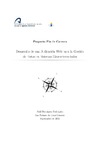Identificador persistente para citar o vincular este elemento:
https://accedacris.ulpgc.es/handle/10553/11812
| Campo DC | Valor | idioma |
|---|---|---|
| dc.contributor.advisor | Sánchez Pérez, Javier | - |
| dc.contributor.author | Martín Rodríguez, Saúl | - |
| dc.date.accessioned | 2014-06-04T02:30:45Z | - |
| dc.date.accessioned | 2018-06-04T13:51:07Z | - |
| dc.date.available | 2014-06-04T02:30:45Z | - |
| dc.date.available | 2018-06-04T13:51:07Z | - |
| dc.date.issued | 2014 | en_US |
| dc.identifier.other | Gestión académica | - |
| dc.identifier.uri | https://accedacris.ulpgc.es/handle/10553/11812 | - |
| dc.description.abstract | El objetivo que se pretendía alcanzar con la realización de este proyecto era desarrollar una aplicación web 2.0 capaz de gestionar rutas independientemente de su tipología u otro tipo de características. El usuario de la aplicación construida tras analizar este proyecto puede crear rutas y modificarlas. Para su visualización se ha optado por un entorno 3D que muestra el globo terráqueo de manera realista: Google Earth en su versión como complemento para navegadores. La variedad de rutas creadas puede ser muy amplia, como por ejemplo: las etapas de la Vuelta Ciclista a España, la travesía de una competición náutica, el recorrido que siguió Colón en su primer viaje a América o los caminos reales de Canarias. Las rutas se crean desplazando el ratón y haciendo clic sobre la superficie del globo terráqueo. La aplicación muestra una línea que pasa por los puntos indicados con la representación de la ruta. Para las rutas creadas el usuario puede añadir una serie de elementos multimedia que permitan obtener un mayor conocimiento de dichas rutas. La aplicación permite añadir fotos, vídeos web, documentos y elementos 3D. Cuando el usuario seleccione mostrar una ruta creada previamente a la que le ha añadido alguno de los elementos indicados previamente, éste se visualizará en el navegador. Además de la posibilidad de gestionar rutas, el usuario también puede gestionar sitios de su interés de manera sencilla. El usuario puede incorporar localizaciones de diversa índole a su biblioteca de elementos para disponer de una mejor accesibilidad de sus lugares predilectos. Los sitios de interés creados aparecen en el globo como un icono junto con su nombre. | en_US |
| dc.description.abstract | The goal to be achieved through the realization of this project was to develop a web 2.0 application capable of managing routes regardless of their type or other characteristics. The user of the application built after finishing this project can create and modify routes. To display them, it has been decided to use a 3D environment realistically globe : Google Earth in its version as a browser plugin. The variety of created routes can be very broad, such as: the stages of the Tour of Spain, the journey of a sailing competition, the tour that followed Columbus on his first voyage to America or the Caminos Reales (main roads) of the Canary Islands. Routes are created by moving the mouse and clicking on the surface of the globe. The application displays a line through the points shown by the representation of the route. For the created routes, the user can add a number of multimedia elements to obtain a better understanding of those routes. The application allows the user to add photos, web videos, documents and 3D elements. When the user selects a route previously created with at least one of the elements mentioned previously, it will be shown in the browser. Besides the possibility of managing routes, the user can also manage place-marks easily. The user can enter locations of various kinds to their elements library to provide better accessibility of their favorite places. Created land-marks appear on the globe as an icon next to its name. | en_US |
| dc.format | application/pdf | - |
| dc.language | spa | en_US |
| dc.rights | by-nc-nd | - |
| dc.subject | 120317 Informática | en_US |
| dc.title | Desarrollo de una aplicación web para la gestión de rutas en sistemas georreferenciados | en_US |
| dc.type | info:eu-repo/semantics/studentThesis | en_US |
| dc.type | StudentThesis | en_US |
| dc.compliance.driver | 1 | - |
| dc.contributor.departamento | Informática y Sistemas | en_US |
| dc.contributor.facultad | Escuela de Ingeniería Informática | en_US |
| dc.identifier.absysnet | 697759 | - |
| dc.investigacion | Ingeniería y Arquitectura | en_US |
| dc.rights.accessrights | info:eu-repo/semantics/openAccess | - |
| dc.type2 | Proyecto fin de carrera | en_US |
| dc.utils.revision | Sí | en_US |
| dc.identifier.matricula | TFT-25925 | - |
| dc.identifier.ulpgc | Sí | en_US |
| dc.contributor.buulpgc | BU-INF | en_US |
| dc.contributor.titulacion | Ingeniero en Informática | - |
| item.grantfulltext | open | - |
| item.fulltext | Con texto completo | - |
| crisitem.author.orcid | 0000-0003-2423-5309 | - |
| crisitem.author.fullName | Martín Rodríguez, Saúl | - |
| crisitem.advisor.dept | GIR IUCES: Centro de Tecnologías de la Imagen | - |
| crisitem.advisor.dept | IU de Cibernética, Empresa y Sociedad (IUCES) | - |
| crisitem.advisor.dept | Departamento de Informática y Sistemas | - |
| Colección: | Proyecto fin de carrera | |
Visitas
174
actualizado el 11-ene-2025
Descargas
1.315
actualizado el 11-ene-2025
Google ScholarTM
Verifica
Comparte
Exporta metadatos
Los elementos en ULPGC accedaCRIS están protegidos por derechos de autor con todos los derechos reservados, a menos que se indique lo contrario.
